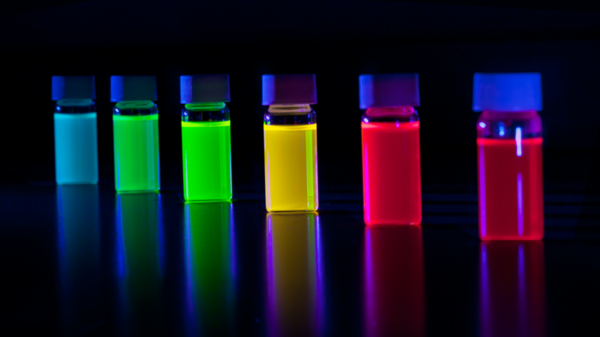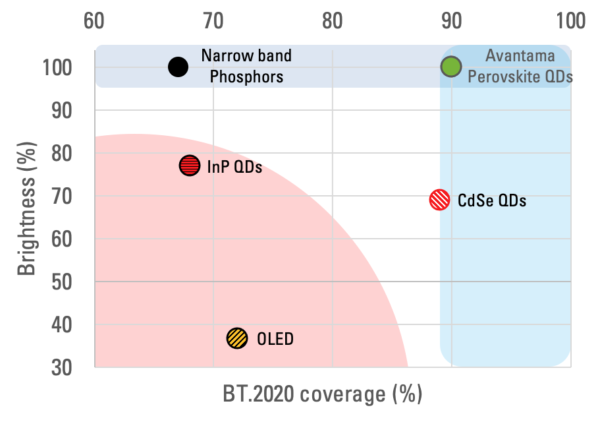What are Metal Halide Perovskite Quantum Dots?
Intriguing Optoelectronic Properties of Metal Halide Perovskites
Metal halide perovskites have been hailed as something of an optical wonder material for use in photovoltaics.1 This is due to their excellent optical properties, including high absorption and emission efficiencies. Metal halide perovskites have the general chemical formula ABX3, where X is a halide and A and B are the cation and divalent metal anion, respectively.
Perovskites can be manufactured in a variety of forms, including metal halide perovskite quantum dots. From a manufacturing perspective, metal halide perovskite quantum dots are more straightforward to make as solution-phase processing techniques can be used. They also require the use of less complex starting materials than CdSe quantum dots.

Perovskite Quantum Dots
Using Metal Halide Perovskites for Light-Emitting Diodes
Metal halide perovskite quantum dots for use in both energy materials and light-emitting diodes is an active area of research. In energy materials applications, the long carrier diffusion length of metal halide perovskite quantum dots is one of the reasons why these materials have seen such rapid gains in photovoltaic efficiency.2
Using Metal Halide Perovskites for Optical Applications
The application of metal halide perovskite quantum dots as colour filtering materials in displayscomes from the ability to tune the band gap and, therefore, the color of the emission by changing the composition of the quantum dot. This and the incredibly high quantum yield of emission make them ideal for use in low-power consumption displays.3
Are Metal Halide Perovskites Unstable?
One of the issues surrounding the widespread adoption of metal halide perovskites, particularly in energy applications such as solar energy cells, has been their stability.4 Concerns about moisture, oxygen and long term thermal stability have hindered their uptake in commercial devices, despite their outstanding optical properties.
Some metal halide perovskites also contain lead as part of their chemical composition, which makes the relatively short device lifetimes and poor thermal stabilities an environmental concern as well. The relatively good water solubility of many metal halide perovskites is an advantage in regards to solution processing and the manufacturing of devices but makes leeching and contamination a more significant concern.
Resolving Thermal Stability Issues of Metal Halide Perovskites
Metal halide perovskite quantum dots seem to be the answer to the stability problems that have plagued conventional metal halide perovskites for many years.
The metal halide perovskite quantum dots show enhanced stability with respect to their thin-film counterparts, both for moisture and temperature stability, and can be designed to be very stable with respect to agglomeration.
Avantama, who are leaders in high-tech materials, has now developed a range of metal halide perovskite quantum dots that overcome all of the stability limitations of previous metal halide perovskite materials.4

Avantama Perovskite quantum dots versus LG OLED TV versus Samsung QLED TV
After many years of research into the factors affecting metal halide perovskite quantum dot stability, Avantama has perfected a strategy capable of stabilizing these outstanding optical materials. This involves the use of composition doping to create custom synthesized metal halide perovskite quantum dots that have added stabilizing elements.
In addition to this, Avantama has used proprietary encapsulation technologies to increase the stability of these metal halide perovskite quantum dots further so that they can be used in nanoparticle dispersions. This is a key step in harnessing the power of these optical wonder materials for printed electronics applications.
References and Further Reading
- Zhang, W., Eperon, G. E., & Snaith, H. J. (2016). Metal halide perovskites for energy applications. Nature Energy, 16048, 1–8. https://doi.org/10.1038/NENERGY.2016.48
- Yuan, J., Hazarika, A., Zhao, Q., Ling, X., Moot, T., Ma, W., & Luther, J. M. (2020). Review Metal Halide Perovskites in Quantum Dot Solar Cells : Progress and Prospects. Joule, 4(6), 1160–1185. https://doi.org/10.1016/j.joule.2020.04.006
- Xiang, W. (2021). A review on the stability of inorganic metal halide perovskites : challenges and opportunities for stable solar cells. Energy & Environmental Science, 14, 2090–2113. https://doi.org/10.1039/d1ee00157d
- Avantama (2021) Solving Stability Issues, https://avantama.com/solving-stability-issues-perovskite-qds/, accessed November 2021